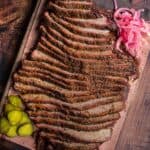Smoked Brisket Flat Recipe
Slowly cooked brisket flat with a tender and rich flavor and finish. An easy step-by-step guide.
Servings: 6 people
Cost: $40
Equipment
Ingredients
- 5 pounds brisket flat Trimmed with no more than ¼ inch fat cap.
- 2 tablespoons extra virgin olive oil
Brisket Seasoning
- 1 tablespoon kosher salt
- 1 tablespoon coarse black pepper
- 1 tablespoon paprika Smoked paprika works as well.
- ½ tablespoon granulated garlic
- ½ teaspoon cayenne pepper Optional if you like heat, leave out if you don't.
Basting Liquid
- 1/4 cup beef stock
- 2 tablespoons Worcestershire sauce
Instructions
- Prep – Prepare the smoker and target 250 degrees F with fruit wood, like apple or cherry. Oak also works well.
- Smoke – Place the seasoned brisket on the smoker. To assist in monitoring the internal temperature, we strongly recommend a good Bluetooth temperature probe. This allows you to watch both the ambient temperature of your smoker and the internal temperature of the meat. Smoke for up to 5 hours or until the internal temperature of the brisket is between 165 and 170 degrees Fahrenheit.
- Wrap – Once the flat hits 165 to 170, remove any probes and place fat cap side down onto two sheets of butcher paper. Pour the basting liquid over the brisket and tightly wrap up the paper. Insert the thermometer again into the thickest part of the flat. Continue smoking until it reaches an internal temperature between 200 – 210 degrees Fahrenheit using a separate instant read thermometer probe. No two smoked brisket flats are ever the same. And the reason to probe with another Thermometer is because you are testing the tenderness. The probe should insert like room temperature butter (aka very soft and tender). There should be no tension when inserting the probe in multiple areas of the brisket. Once you experience the butter-like feeling, then remove from the smoker and let it rest.
- Rest – After removing the brisket flat from the smoker let it rest 30 – 60 minutes in cooler with no ice. The resting period allows the brisket to slowly finish cooking and redistribute all the flavorful juices while keeping the meat tender.
- Slice – After it has rested, slice the brisket into pencil thin slices. When you slice, be sure to slice perpendicular to the grain. This means you will likely cut the rectangular flat at an angle and will have various sized pieces. This helps keep the cells intact and with tenderness.
Notes
Trimming Brisket Point -
- Using a sharp boning knife, start with the fat cap side and reduce the fat cap to no more than 1/4 inch. This layer of fat can be too thick and won’t render fully. Discard the fat.
- Flip it over and then remove any excess fat pockets and silver skin.
Nutrition
Calories: 801kcal | Carbohydrates: 3g | Protein: 56g | Fat: 61g | Saturated Fat: 19g | Polyunsaturated Fat: 3g | Monounsaturated Fat: 31g | Cholesterol: 204mg | Sodium: 5839mg | Potassium: 1215mg | Fiber: 1g | Sugar: 1g | Vitamin A: 128IU | Vitamin C: 105mg | Calcium: 39mg | Iron: 7mg
